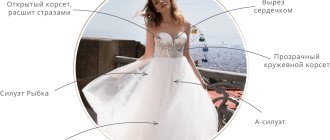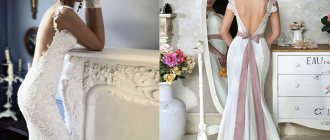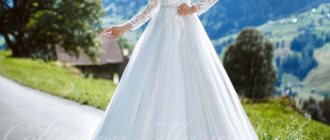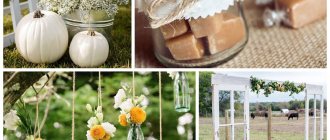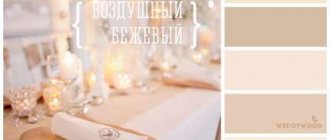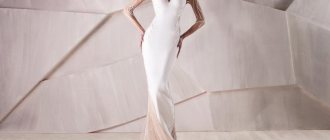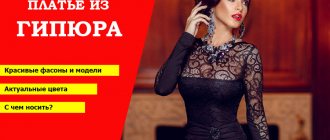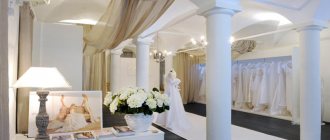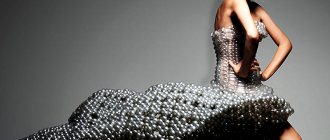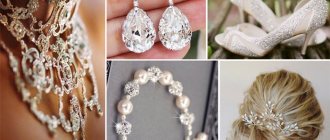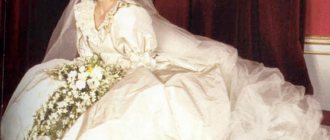What to look for when choosing fabric
The fabric for a wedding dress should be selected so that it is suitable for the weather, the style of the event, the place where it is held, is pleasant to the touch, and is comfortable for the bride to wear all day long. Distinctive properties of fabric for sewing wedding dresses:
1. Wrinkle-resistant. The bride is constantly being filmed on photo and video cameras, and you don’t want the hem of the dress to be wrinkled.
2. Durable and elastic. You will have to wear the dress all day, you will have to move and dance in it a lot. Sometimes the hem of a dress is stepped on, and it should not tear at the slightest touch.
3. Breathable - so that the bride feels comfortable in any weather.
4. Matching style. A fabric that is too light will not hold its shape and will not allow you to create drapery. And from dense fabric such as taffeta it is impossible to create the impression of flowing material.
5. Moderately shiny so as not to create glare in the photo.
For a wedding planned for the summer, light, airy fabrics are more suitable. If the celebration takes place in winter, then an outfit made of thick material would be appropriate.
Main options
The most popular fabrics for wedding dresses are:
- silk;
- atlas;
- crepe;
- chiffon;
- organza;
- taffeta;
- brocade;
- velvet.
Sometimes they are combined with each other, creating a unique image. Each material has both advantages and disadvantages.
Atlas
Thanks to its rich appearance, durability and ease of processing, satin is one of the fabrics most often used for celebrations. It can be dense and lightweight, natural and artificial. Its advantages are:
• has a shiny, smooth surface that makes the fabric elegant;
• holds its shape perfectly due to its density;
• drapes easily, so satin can be used to create complex designs consisting of several layers;
• withstands decoration from beads, rhinestones, bugles, crystals, without stretching or sagging.
This rich material combines well with other fabrics. This is why fashion designers love it, combining it with various matte fabrics, lace, organza, embroidery and creating a harmonious wedding look.
A satin dress is indispensable if the wedding is scheduled for the cold season. In addition, it will be appropriate in luxurious interiors. Any style is suitable for this fabric.
The disadvantages of satin include the fact that it wrinkles easily. The bride should also remember that in the summer she will be very hot in a wedding dress made of thick fabric.
Advantages and disadvantages
The positive and negative features of fabrics for bridesmaid dresses are presented in table form.
| Fabric name | pros | Minuses |
| Silk | It looks very noble and expensive. The fabric is light and does not create discomfort when moving. Silk products fit well to the body. | It wrinkles a lot and is not cheap. The work should be entrusted exclusively to an experienced specialist, since sewing from silk is difficult. |
| Atlas | A satin dress looks luxurious and elegant, comfortable to wear, and absorbs moisture well. The material is very durable and has a long service life, does not generate static electricity. | It falls off when sewing and shrinks after washing in warm water. The dress will be quite heavy. In summer it is hot in such clothes. The cost of the atlas is quite high. |
| Crepe | The material is very durable, yet lightweight, retains its color and noble appearance for a long time. Practically does not wrinkle, goes well with lace. | Difficult to care for. It has an impressive price. Hand wash preferred. |
| Chiffon | The fabric looks beautiful: shine and soft tints create a romantic image. Absorbs moisture well. Softness provides comfort during use. The fabric does not stretch or wrinkle. | Sewing from chiffon is quite difficult, it slips and crumbles. The material is fragile; under the influence of the sun's rays, the fabric fades over time. There is a tendency to form puffs. |
| Organza | Looks beautiful in the photo and matches with a variety of finishes. Very durable and retains its shape for a long time, practically does not wrinkle. It's inexpensive. | The fabric is very sheer, so be sure to use a lining. Ironing must be done carefully - fragile organza can easily be burned. |
| Taffeta | Increased strength, attractive appearance. Keeps its shape and drapes well. | After washing, the dress may shrink. Doesn't smooth out well, especially on folds. During cutting, the material frays a lot. |
| Brocade | The dress is suitable for a ceremony in winter. It looks luxurious and aristocratic. Brocade is very durable, goes well with other materials, and holds its shape perfectly. | High price. The fabric is difficult to care for and quickly loses its attractive appearance due to wear and tear of the threads. |
| Velvet | It looks very feminine and elegant. This dress is comfortable to wear, it does not lose its shape and retains heat well, so it is suitable for a wedding in winter. | High price. Difficult to sew and care for. It will be very difficult to remove a accidentally placed stain from a velvet dress. Over time, abrasions and shiny areas may appear on the garment. |
Each material for a wedding dress has both positive and negative sides. Therefore, we suggest that you get acquainted with the advice of experts in order to avoid mistakes and not spoil the main day of your life.
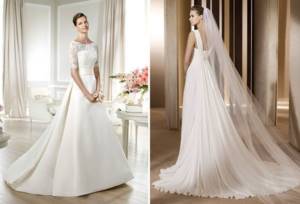
Taffeta
If you dream of pomp and elegance at your own wedding, then taffeta is your choice. This dense silk, cotton or synthetic fabric has a glossy texture, does not wrinkle and shimmers in different colors in different lighting.
Outfits made from taffeta perfectly retain their shape, so skirts with drapery, fluffy dresses with a corset, and A-line models, which are decorated with lace, rhinestones, beads or beads, are often made from it. Silk or cotton taffeta produces a characteristic rustling sound when moved. This will give the bride additional charm.
Taffeta outfits will be appropriate both in summer and winter. If necessary, the hem of a wedding dress made of shiny fabric is made of several layers - then it will be warmer.
Fabric for the base of a wedding dress
The basis can be satin, brocade, crepe, silk, etc. And they can be divided according to the following principle:
- material for summer outfits,
- material for winter clothes.
Summer fabrics
The most wedding season is, of course, summer. And this time of year is often characterized by high temperatures. Therefore, summer wedding fabrics should be natural and light.
Silk is one of the most expensive and most difficult materials to process. In addition, natural silk is very wrinkled. However, its mesmerizing beauty outweighs all the disadvantages. For silk, outfits with a simple cut, with a flowing or slightly tight-fitting skirt, for example, the Greek style, are more suitable. The bodice of a wedding dress can be decorated with lace or pearl thread. To make your skirt wrinkle less, you should choose silk with the addition of artificial fibers.
Satin is very popular in the wedding industry. In addition to being an excellent fabric for sewing a wedding dress, satin is used to trim clutches, pouches, and bridesmaid shoes. It is ideal for sewing fluffy dresses with an A-line skirt. Only satin is not suitable for an open-air wedding in the heat, but if the celebration takes place indoors with air conditioning, it will do just fine.
Satin can be made from synthetic fibers or cotton. In the first case, the material has a silky shine, in the second - a matte surface. It is used to make loose-fitting dresses in the Empire, Greek or boho styles. For an outdoor wedding in hot weather, a light cotton cropped dress would be the best option.
Taffeta, consisting of silk fibers, is distinguished by its light rigidity and shine; it drapes well, takes and retains various shapes: crochet, pleated, corrugated. The peculiarity of this fabric is that it does not wrinkle, and for sewing a wedding dress this is a huge plus.
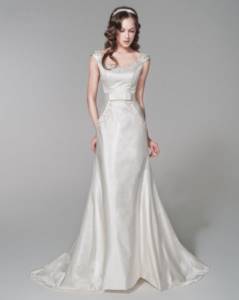
Crepe is universal for wedding and evening dresses made of natural or synthetic fibers. For the summer option, it is better to choose natural ones. The material has a smooth, matte or shiny surface, combined with lace.
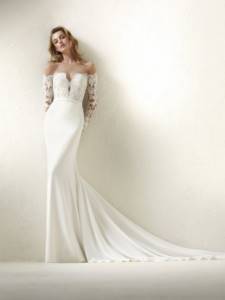
Winter fabrics
In winter, the celebration will most likely take place indoors, but you should choose a dress from a thicker fabric, because you will still have to take several walks in the fresh air.
Satin suits winter outfits just as well as summer ones. It will make a beautiful classic wedding dress with a full skirt and long sleeves.
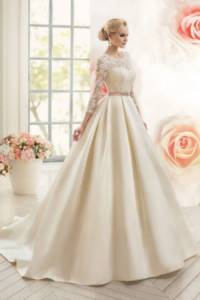
Artificial crepe is suitable for a bride's winter suit, because... it keeps warm. Irish lace or beaded patterns are suitable as decor.
Wedding dresses made of thick fabric such as brocade do not require embellishment. In ancient times, it was worn by high-ranking persons because of its high cost; it contained fibers of gold or silver. Today, production has been simplified and the price has decreased, so girls often choose dresses made from this fabric. The delightful volume and shine of brocade will add royal luxury to the bride’s image.
Taffeta, consisting of cotton fibers, is used to make winter bridesmaid dresses. It holds its shape perfectly, so it is ideal for models with full skirts, pleats, and flounces.
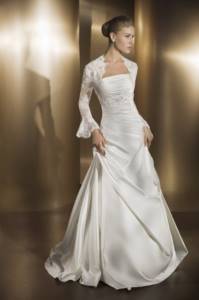
Jacquard for a winter wedding dress is a great find. It is dense, light and wrinkle-resistant due to the combination of natural and artificial fibers, as well as a special weave of threads. Jacquard has a variety of colors and textures and looks chic both on its own and in combination with other materials.
Brocade
This is another favorite when creating luxurious wedding dresses. Since ancient times, such fabric has been considered a symbol of wealth, since it was made from silk, adding gold threads (now they have been replaced by metal ones). Thanks to this design, the fabric looks very beautiful, it is strong and durable. No additional elements or decorations are required. A brocade outfit is best suited for the cold season. It can beautify a girl with any figure, as it has the ability to successfully demonstrate advantages and hide flaws.
Brocade fabric provides excellent protection from the cold, making it suitable for weddings in the winter and autumn months. A brocade dress complete with a snow-white fur coat will make the newlywed a real queen.
Satin wedding dresses
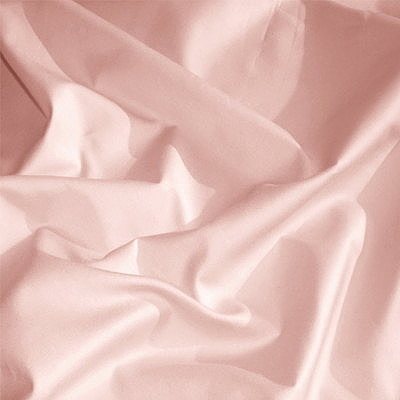
Satin. Photo: textile-home.ru
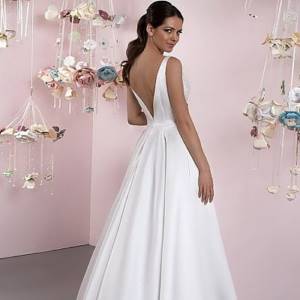
Satin wedding dress
Satin is a dense material with a shiny and smooth surface. Sometimes satin is confused with silk or satin: this happens because the basis of the fabric can be different fibers, including silk. But satin, unlike silk, is very durable and almost does not wrinkle.
Other important advantages include that it does not electrify and is pleasant to the touch. Brides who choose satin wedding dresses should remember that in this material any girl will look quite strict and restrained. Therefore, satin is perfect for brides 30+ and those who prefer laconic elegance.
Advertising - Continued below
Silk
Silk has always been a very expensive material, so only truly wealthy people could afford outfits made from it. Recently, manufacturers have been producing silk with synthetic admixtures, which makes it a little cheaper. At the same time, it looks as beautiful and luxurious as natural fabric.
Silk fabric is very popular due to its luxurious appearance, lightness and airiness. This outfit gives the bride elegance and requires almost no additional accessories. For a silk dress, it is best to choose tight-fitting styles: for example, mermaid and A-line.
The disadvantages of silk include its ability to wrinkle a lot, due to which the outfit will look untidy. Fashion designers do not like this material because it is difficult to work with - it slips and slides off the table. Girls with curvy figures need to remember that a silk dress will show off all the flaws in their figure.
Types of materials
In the modern world there is a large selection of materials for creating brides' wedding dresses. With such a wide selection, designers always have the opportunity to create exactly what they want. In addition, some fabrics help create real works of art, while with the help of some you can simply reduce the cost of the product itself.
Atlas
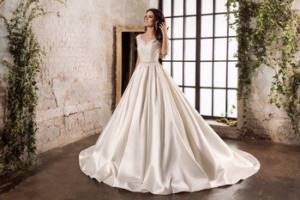
A classic material that is most often used as a fabric for evening wear. Brides love it for the natural shine and glossy shade it creates in the sun. A large number of designers and fashion designers made satin outfits.
They love this fabric because it is easy to combine with many interesting details and draperies. Satin goes well with decorative elements such as lace, silk and organza. In addition, you can always add rhinestones and beads to such a dress. In this case, your image will be more rich and complete.
Silk
Recognized as the most expensive, luxurious and beautiful fabric. Recently there is silk with synthetic admixtures. It looks completely different than a product made from natural material. Working with silk is quite difficult, so not all fashion designers take it up.
However, know that if you find a similar product made from natural material, it will be distinguished not only by its excellent quality, but also by its special tailoring. Stylists have always said that one of the main disadvantages of silk is that it adds extra volume.
Therefore, it is best suited for those young ladies who initially have a slim or even thin figure. With excess weight, the girl will look even bigger. If the bride is ready for this, then she can choose silk.
Cotton
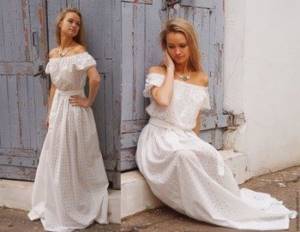
Wedding fabric for dresses, which has only recently become widespread. It is actively used for outfits in Provence, boho or rustic styles. It often serves as the main material for national wedding ceremonies. We love cotton for its natural quality.
It is perhaps impossible to find a more natural fabric. It's convenient and comfortable. It doesn't wrinkle much and fits quite nicely to the body. Cotton looks equally good on both long and very short outfits.
The main emphasis in this image can be placed on simplicity. In this case, a girl often complements her wedding look with a headdress or bright accessories.
Organza
When answering the question of what fabrics wedding dresses are made from, designers often name organza. This fabric, containing polyester, viscose and silk, is highly breathable, durable, lightweight and does not wrinkle.
The rigidity of the material makes it possible to make magnificent outfits from it. In the sun, this fabric shimmers in different colors, surrounding the image of the bride with some mystery. Organza makes the most voluminous skirts, flounces and voluminous sleeves.
An organza dress is suitable for both summer and winter weddings. In this light material, the bride will not feel the influence of the summer heat. But if you make a multi-layer drapery from organza, then this outfit will be cozy even in winter.
Guipure
This translucent fabric with an openwork relief pattern is called Venetian lace. Guipure is often used as an effective addition to chiffon, cotton and linen fabrics, but entire dresses are also made from it. In this case, a lining will be required.
A guipure dress does not require additional finishing or a large number of decorations.
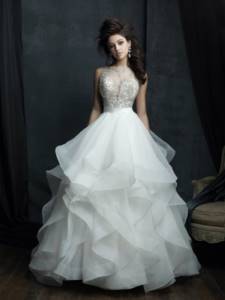
Allure Bridals Wedding dress AB C380 175,000 ₽ Allure Bridals A-line Asymmetry from 150 to 200 thousand Floor-length With corset Provence
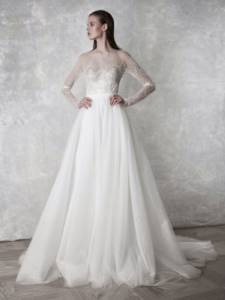
Lana Marinenko Wedding dress OW0104 Custom Lana Marinenko A-line Long train Wedding Long sleeve Custom design Prom
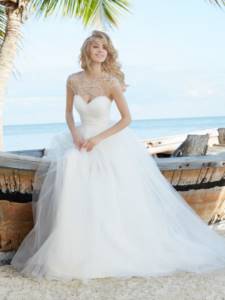
Hayley Paige Wedding dress HP 1500 132,300 ₽ Hayley Paige A-line Beach Open back from 100 to 150 thousand Floor-length With a corset For prom
What does our company offer
When planning a wedding, many representatives of the fair sex are interested in what material wedding dresses are made from. Nowadays there is a huge selection of wedding dresses made from different materials, different styles and colors. Wedding salon "Vanilla" will help you decide on a dress for the most important day of your life. We present interesting modern models and will select an option for you, taking into account the characteristics of your figure, taste, wishes and budget. Here you will find dresses from the world's best manufacturers. With our help you will become irresistible!
